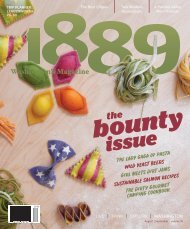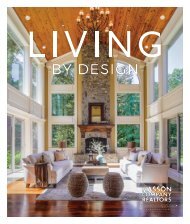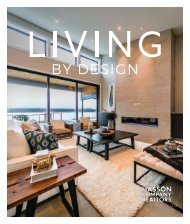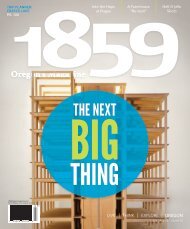Create successful ePaper yourself
Turn your PDF publications into a flip-book with our unique Google optimized e-Paper software.
Oregon Living<br />
design<br />
photos by Dina Avila<br />
THE LEGACY HOUSE<br />
Bruce Drake, a business professor at the University of Portland, first saw the cottage on his<br />
morning commute through Portland’s Mocks Crest neighborhood. He loved the stonework<br />
in the home’s facade and the circular window nestled within it—features more common to<br />
houses in the English countryside than the Pacific Northwest. “It was absolutely elegant,” he<br />
recalls. “I thought, if that house ever goes up for sale, I’m buying it.” Soon after, a ‘For Sale’ sign<br />
out front prompted him and his wife, Eileen, to inquire.<br />
They discovered that the cottage had a rich history. It was a model home built by The Oregonian<br />
in 1928, designed to demonstrate how native woods could produce highly decorative<br />
effects. By the time the Drakes stepped inside seventy-four years later, however, the interior<br />
was a disaster. A 1970s-era kitchen renovation had left dark cabinets, laminate flooring and a<br />
green-orange backsplash. Moreover, there was poorly installed sheetrock, and layers of paint<br />
and carpet that had diminished the original woodwork. Despite this, the couple bought the<br />
house in 2002, and decided to restore it using sustainable and salvaged materials.<br />
Bruce found fifty newspaper articles describing the house’s construction. Next, the couple<br />
hired Karen Richmond, a designer with Neil Kelly, to help them get the historic details right.<br />
Once they started the demolition, the house proffered more clues about its original form.<br />
While gutting the kitchen, they found a remnant of bullnose tile inside the wall that would<br />
inspire new countertops. A built-in closet in the master bedroom was hidden behind drywall.<br />
All of their hard work paid off when the finished home was accepted into the National<br />
Register of Historic Places. In a strange twist, Bruce learned that the cottage ’s original architect<br />
was his great uncle. This discovery, he says, made his first sighting of the house, and its subsequent<br />
restoration, seem much like fate.<br />
The Goods<br />
Homeowners Bruce and Eileen Drake<br />
Design/Build Karen Richmond | Neil Kelly | neilkelly.com<br />
DIY RESTORATION OF VINTAGE FURNITURE<br />
Refinishing furniture is expensive, time-consuming and not always necessary. Try these tips before you resort to stripping the piece.<br />
CLEANING is always step one and<br />
may be enough to give the piece a new<br />
life. Use an oil-based wood cleaner.<br />
If this isn’t enough, use a mild solution of<br />
warm water and liquid detergent. Rinse and<br />
thoroughly dry with a soft cloth. If a “haze” is<br />
left over, buff lightly with steel wool—following<br />
the direction of the wood grain.<br />
114 <strong>1859</strong> oregon's mAgAzine SEPT OCT <strong>2012</strong><br />
RE-AMALGAMATION helps when<br />
finishes crack, leaving an alligator-like<br />
pattern on the wood. Use a solvent to<br />
eliminate deep grime and cracks. Apply with<br />
a clean, dry natural bristle brush and work in<br />
quick, long strokes. Multiple coats may be necessary.<br />
When complete, lightly buff with the<br />
grain. To finish, wax with a hard paste and buff.<br />
1 2 3<br />
OVERCOATING enhances wood color.<br />
Find a stain that matches the current<br />
color. Stain the entire piece, let set<br />
for fifteen minutes and rub off. Repeat until<br />
stain matches original. When dry, buff with<br />
steel wool and polish with a tack cloth. Apply<br />
a coat of the original finish. Let set two days.<br />
Buff, wax with a hard paste and polish.

















